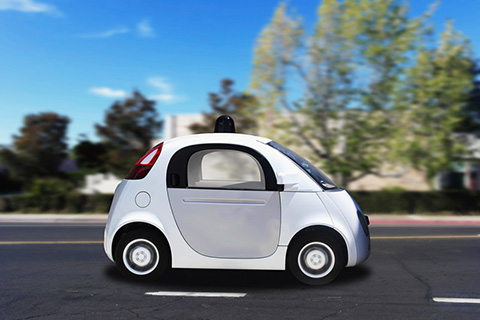As if Uber hadn’t rattled city policy-makers enough, consider this not too far-fetched scenario: What happens when the ride-sharing company begins to dispatch driverless cars to pick up and drop off passengers?
When that futuristic vehicle pulls up in front of your dwelling, “it’s probably too late for governments to think about how to start regulating,” observes Sara Ditta, a policy associate at U of T’s Mowat Centre and the co-author of a recent report on automated vehicles.
Uber, which has prompted protests by taxi drivers in many cities, offers a cautionary tale about what happens when governments fail to think ahead about disruptive technology, according to Ditta and co-author Noah Zon, a former colleague. Noting that, earlier this year, Ontario became the first Canadian province to authorize tests of fully automated vehicles on public roads, the report’s authors warn: “Governments can’t once again afford to be caught flat-footed.”
The 23-page study identifies several policy areas that will be affected by the presence of driverless cars on roads and highways. In the short term, these include safety, liability and insurance, and employment (about 15,000 people work in Toronto’s taxi industry alone). In the longer term, automated vehicles could affect everything from urban planning to car manufacturing. And because these computerized vehicles will be connected wirelessly to digital networks, they will challenge existing policies on data privacy and security.
Based on the rapid evolution and testing of the technology, and the determination of giant companies such as Google to bring driverless cars to market, Ditta predicts that these vehicles will be available within a decade.
On the one hand, this revolution will bring social benefits, such as enhanced mobility for older people or those with visual or physical impairments. But on the other, as Ditta and Zon point out, there are complex questions about insurance and liability to sort out.
While extensive testing has shown that automated vehicles are safer than conventional ones (partly because they don’t suffer from human failings such as impairment or distraction), questions linger about who is liable when accidents happen. What’s more, existing rules specify that a person needs to be operating the vehicle.
The authors also point out an unintended consequence of this new technology: some vehicles will be only partially automated, so drivers can take over from the computerized navigation system. But as humans reduce the time they spend at the wheel, their driving skills may deteriorate – boosting the risk of accidents. “We ultimately face the question of whether allowing people to operate vehicles makes sense,” the authors write, “given the public health and safety implications when automated systems are demonstrably safer.”
Ditta stresses that the point of the report is not to advocate for specific policies to either help or hinder the rollout of automated vehicles. Rather, she’s pushing decision-makers to stay abreast of technological advances and consider a range of regulatory responses.
Read the complete report.
Recent Posts
U of T’s 197th Birthday Quiz
Test your knowledge of all things U of T in honour of the university’s 197th anniversary on March 15!
Are Cold Plunges Good for You?
Research suggests they are, in three ways
Work Has Changed. So Have the Qualities of Good Leadership
Rapid shifts in everything from technology to employee expectations are pressuring leaders to constantly adapt






